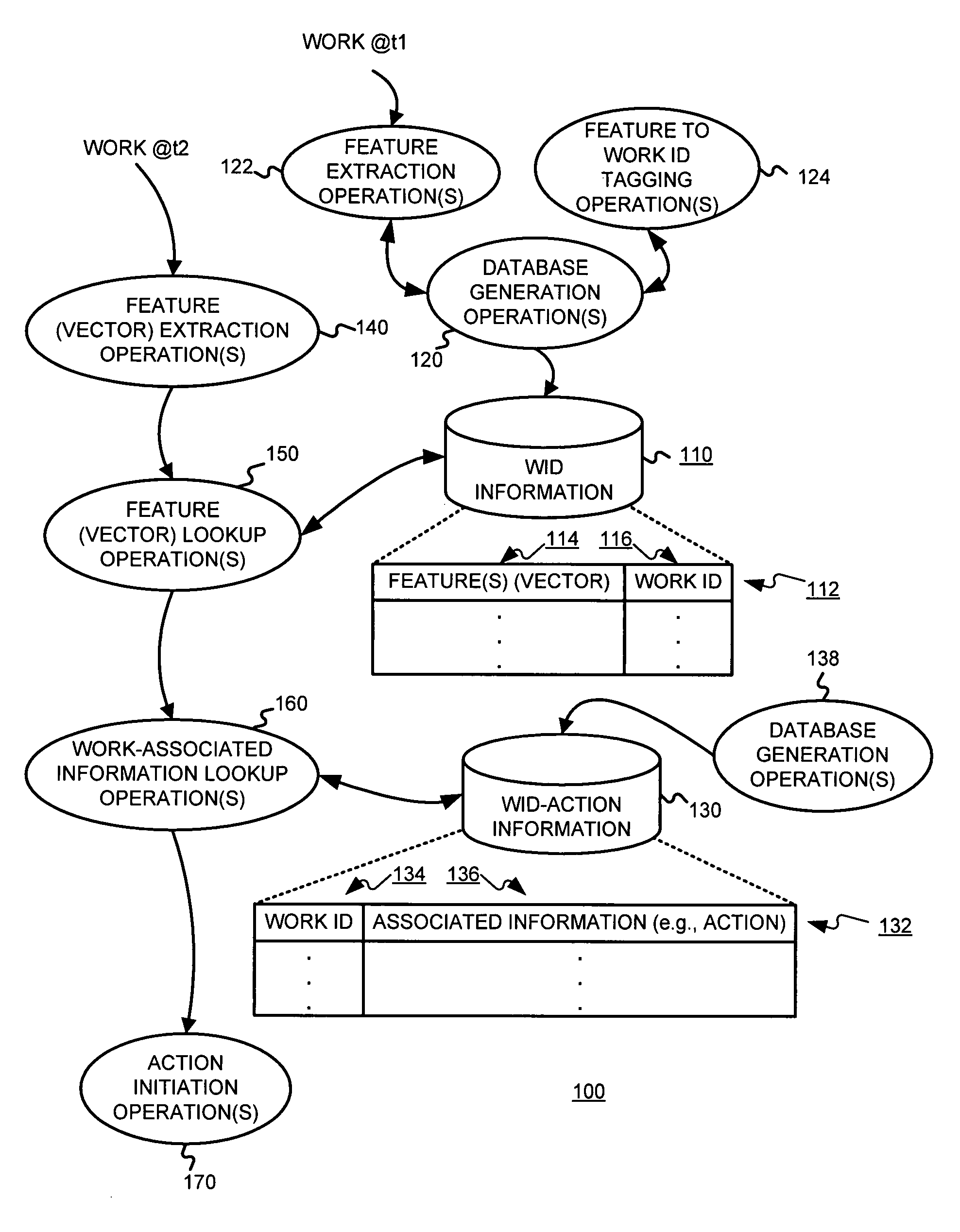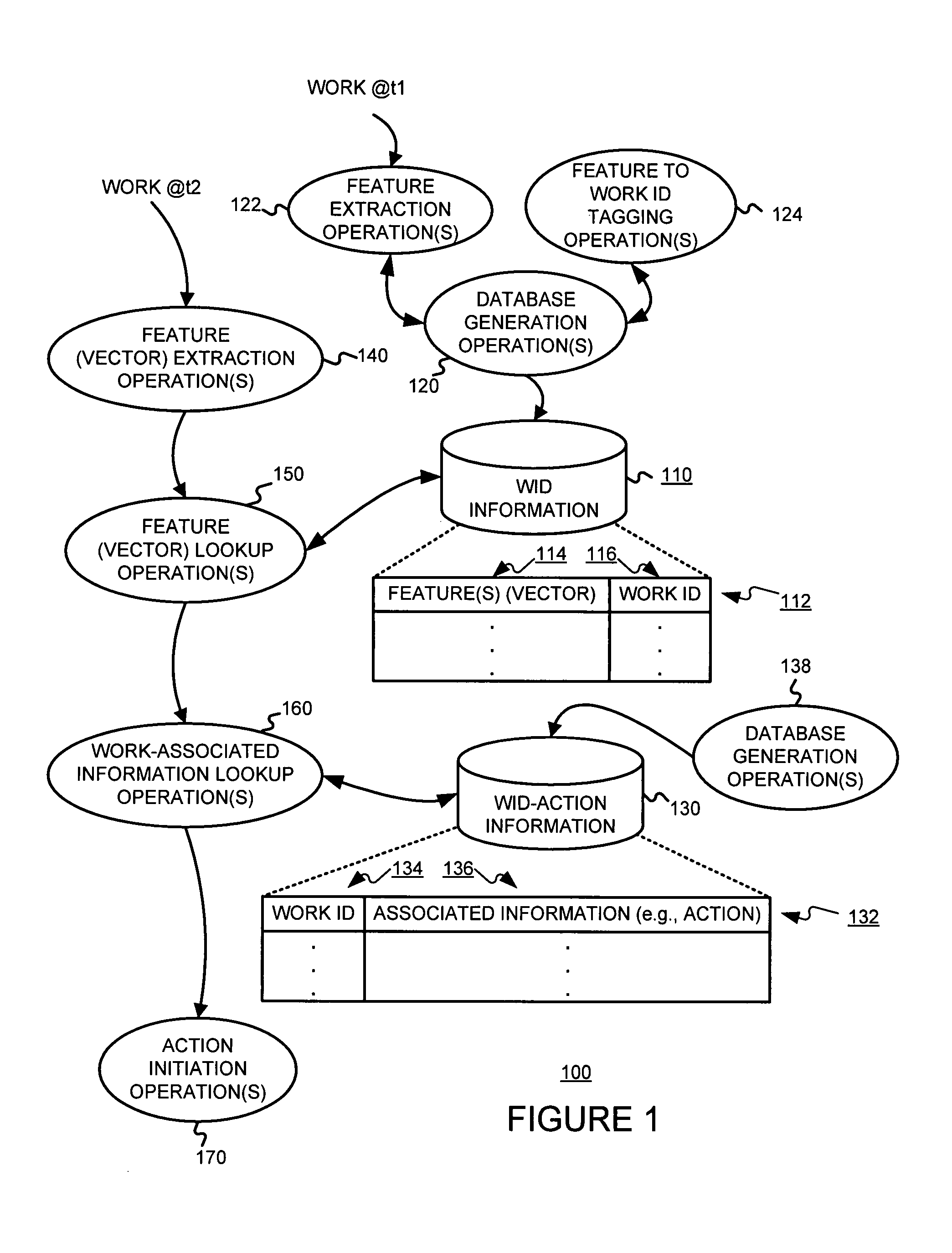Identifying works, using a sub-linear time search, such as an approximate nearest neighbor search, for initiating a work-based action, such as an action on the internet
a technology of work and sub-linear time, applied in the field of identifying works, can solve the problems of not being able to identify the designer or the particular style, modifying the broadcast signal, and not being able to find other information,
- Summary
- Abstract
- Description
- Claims
- Application Information
AI Technical Summary
Benefits of technology
Problems solved by technology
Method used
Image
Examples
first embodiment
[0062]FIG. 2 is a block diagram illustrating the present invention, in which intra-work information is used to identify the work and in which a audience member device 210, such as a PC for example, receives and renders a work that is consumed by an audience member (user). At some point, the user may wish to perform a work-specific action such as traversing to an associated Web site. Upon initiation of this request, the computer 210 performs the operations 140a, 150a, 160a and 170a, such as those shown in FIG. 1. To reiterate, these operations include a feature extraction operation(s) 140a, feature vector lookup or matching operation(s) 150a in connection with items or records 112a in a work-identification (WID) database 110a. If a matching feature vector 114a is found, the work-associated information lookup operation(s) 160a can use the associated work identifier 116a to accessing a work identification-action translation (WIDAT) database 130a to retrieve associated information 136a,...
second embodiment
[0068]FIG. 3 is a block diagram illustrating the present invention, in which intra-work information is used to identify the work. Although the WIDAT database can be quite small, as illustrated in the exemplary embodiment described above with respect to FIG. 2, there is still the problem of keeping this database current. While periodic updates of the local databases may be acceptable, they become unnecessary if the WIDAT database 130b is at a remote location 340. In this arrangement, illustrated in FIG. 3, after the local computer 310 identifies the work, it sends a query to the remote WIDAT database 130b. The query may contain the work identifier. The remote site 340 may then return the associated information 136. Although the remote WIDAT database 130b needs to be updated by the database provider, this can be done very frequently without the need for communicating the updates to the local computers 310.
[0069]The second embodiment is most similar to active systems in which an embedd...
third embodiment
[0071]FIG. 4 is a block diagram illustrating the present invention, in which intra-work information is used to identify the work. Recall that the WIDAT database may be small relative to that work identification database (WID). As the size of the work recognition (WID) database increases, the foregoing embodiments may become impractical. Consider, for example, a music application in which it is desired to identify 100,000 song titles. If it is again assumed that a 1 Kbyte vector can uniquely represent each song, then on the order of 100 Mbytes is now needed. This size is comparable to large application programs such as Microsoft's Office 2000 suite. Although this still does not represent an inordinate amount of disk space, if this data needs to reside in memory at all times, then very few present machines will have adequate resources. Clearly, at some point, the proposed architectures scales to a point where requirements become impractical. In this case, a further modification to the...
PUM
 Login to View More
Login to View More Abstract
Description
Claims
Application Information
 Login to View More
Login to View More - R&D
- Intellectual Property
- Life Sciences
- Materials
- Tech Scout
- Unparalleled Data Quality
- Higher Quality Content
- 60% Fewer Hallucinations
Browse by: Latest US Patents, China's latest patents, Technical Efficacy Thesaurus, Application Domain, Technology Topic, Popular Technical Reports.
© 2025 PatSnap. All rights reserved.Legal|Privacy policy|Modern Slavery Act Transparency Statement|Sitemap|About US| Contact US: help@patsnap.com



